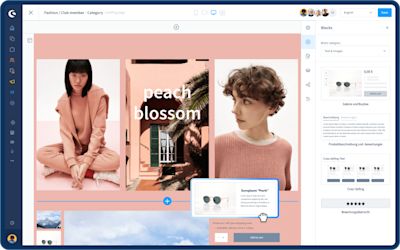
Many companies are struggling with outdated systems in online retail. Traditional monolithic ecommerce platforms were developed during a time when desktop shopping was dominant and changes were rarely necessary. Today, customers expect flexible shopping experiences – whether on mobile, through voice commands, integrated into social networks, or enhanced by augmented reality. However, conventional systems are often cumbersome and inflexible.
The headless approach decouples the backend from the frontend. This separation allows different sales channels to be quickly adapted without overhauling the entire system. This way, you can scale your platforms to remain stable even during peak load times. At the same time, it gives you the freedom to integrate new technologies without being restricted by rigid shop templates.
But is a headless ecommerce platform truly the better choice? In this article, you will learn how it works, the advantages it offers, and what to consider when choosing the right solution.
What is a headless ecommerce platform?
Definition and technical structure
A headless ecommerce platform separates the backend – the management of products, orders, and customer data – from the frontend, which controls the presentation and customer interaction. This decoupling provides greater freedom in designing the shopping experience, as developers are no longer confined to the predefined structures of a monolithic system.
The core of this architecture is an API-first structure. Through application programming interfaces (APIs), the backend communicates with various frontends, whether it's a traditional website, a mobile app, or a smart device. This enables different channels to be optimized and adjusted independently, allowing for more tailored and consistent shopping experiences across platforms.

Why are more shops adopting headless?
Many retailers are realizing that conventional systems can no longer keep pace with market demands. To successfully drive sales, it’s not just about having an attractive storefront – it’s about delivering a seamless experience across all channels.
A headless ecommerce platform makes this possible by offering:
Independence from standard frontends: Design your own shop interfaces without being limited by predefined themes or templates.
Enhanced scalability: Whether you manage a catalog of 100 or 140,000 products, headless remains performant, even under high order volumes.
Greater flexibility for integrations: New technologies can be incorporated without major structural changes.
For retailers aiming to future-proof their shops, headless architecture is quickly becoming a must-have.
The benefits of a headless ecommerce platform for your business
Switching to a headless ecommerce platform offers greater freedom in scaling, customization, and integrating new technologies. But what does that mean in practice?
Scalability and performance
As a shop grows, so do the demands on the system. An expanding product catalog, increasing traffic, and international expansion require a platform that remains stable even under heavy load.
Reliable performance under heavy load: Headless platforms are designed to handle large volumes of requests simultaneously. Systems like Shopware can process over 4,000 orders per minute and manage product catalogs with more than 140,000 items.
Independent scaling of frontend and backend: You can adjust server and cloud resources as needed without having to overhaul the entire system.
Flexible integration of external systems: Inventory management, payment providers, or CRM solutions can be seamlessly integrated via API without compromising the shop’s performance.
For shops that experience frequent traffic spikes – such as during sales events or seasonal peaks – this architecture ensures the site remains fast and responsive, preventing bottlenecks and downtime.
Enhanced customer experience and personalization
Today’s customers expect more than just a functional storefront. They want a tailored shopping experience – whether they’re browsing via a website, mobile app, or social media.
Consistent brand experience across all channels: A headless approach allows you to develop optimized interfaces for every touchpoint without managing content multiple times.
Personalized product recommendations: AI-driven suggestions present customers with items that are most relevant to them, increasing the likelihood of a purchase.
Advanced technologies like AR and Voice Commerce: Integrating new technologies becomes easier, as the backend remains flexible and doesn’t require extensive modifications.
These capabilities can significantly boost conversion rates, as customers receive more targeted offers and enjoy a smoother, more intuitive purchasing process.
Future-proofing and freedom in technology stack
Technology is constantly evolving – choosing a rigid platform today can mean facing a costly overhaul in just a few years. Headless platforms offer a critical advantage in this regard:
Freedom to choose the frontend stack: Businesses can opt for React, Vue.js, Angular, or any other technology that aligns best with their strategy.
Easier integration of emerging trends: Whether it’s Progressive Web Apps (PWAs), voice control, or interactive product visualizations – new features can be implemented flexibly.
Vendor independence: With an API-first approach, businesses can swap out or adjust individual components without being locked into a closed system.
This level of flexibility ensures that your ecommerce platform can keep pace with technological advancements and changing customer expectations.
How to choose the right headless ecommerce platform
Not every platform labeled as “headless” offers the same features. It’s essential to carefully assess which system best fits your needs. Some platforms only provide a commerce engine that needs to be integrated into existing structures, while others come with complete backends. There are also significant differences in performance, multi-store management, and hosting options.
The following points outline what to look for when selecting the right platform.




Which headless platform is right for you?
✅ For retailers with high order volumes and complex product catalogs → An API infrastructure with high performance.
✅ For businesses managing multiple brands or international shops → A multi-store function reduces administrative effort and facilitates expansion.
✅ For retailers with limited developer resources → A platform with a pre-built PWA frontend ensures a faster launch.
✅ For companies that want to manage their infrastructure independently → A platform with an on-premise option provides greater control over hosting and data.
Headless Commerce with Shopware: a powerful platform
Shopware is a market leader in Germany, leveraging an API-first architecture that caters to both growing mid-sized businesses and enterprise retailers. Beyond Germany, Shopware is trusted by businesses worldwide, including those in the US, Italy, and the Benelux region.

Why choose Shopware as a headless platform?
API-first architecture: Shopware provides all functionalities via REST APIs, simplifying the integration with external systems and custom frontends.
Scalability: The platform handles thousands of orders per minute and supports extensive product catalogs – ideal for growing businesses.
Multi-store capability: Multiple shops for different brands or countries can be managed from a single instance.
Flexible hosting options: Shopware runs both in the cloud and on-premise, allowing merchants to choose their preferred infrastructure.
Many companies rely on Shopware
Many merchants already use Shopware to flexibly develop their ecommerce business.

✅ Companies managing multiple brands or international shops benefit from the multi-store functionality.
✅ Retailers with extensive product catalogs leverage a powerful API architecture.
✅ B2B shops and custom ecommerce projects can freely design their systems and integrate existing tools.
We’re here for you
Your vision is what drives us. Behind Shopware are people who want to help pave your way to success. Just let us know how we can support you.
Headless ecommerce platforms – frequently asked questions
What is the difference between a headless ecommerce platform and a traditional platform?
A headless ecommerce platform separates the frontend from the backend, whereas traditional systems tightly link both components. This allows businesses to develop different frontends for various channels independently of the backend, without overhauling the entire infrastructure.
What are the benefits of headless commerce for B2B companies?
B2B merchants benefit from headless commerce through customizable product catalogs, customer-specific pricing, and integrations with ERP and CRM systems. Additionally, complex ordering processes can be optimized via custom frontends without altering the backend logic.
Which ecommerce systems are compatible with a headless architecture?
Not all ecommerce systems provide a true headless structure, as some only offer API interfaces without fully decoupling the backend. Systems with an API-first approach, like Shopware, enable complete separation of frontend and backend, giving businesses extensive flexibility in designing their sales channels.
Can an existing Shopware installation be converted to headless?
Yes, Shopware supports both traditional and headless architectures, allowing existing installations to be gradually transitioned to headless. With Shopware’s API-first structure, frontends can be individually customized while the backend continues to manage products and orders.
How does headless commerce impact the loading speed of an online shop?
Headless commerce can significantly improve loading speed, as the frontend can be specifically optimized and stripped of unnecessary code. Modern frontend technologies like Progressive Web Apps (PWA) and Server-Side Rendering (SSR) further accelerate load times, positively impacting conversion rates and Google rankings.











